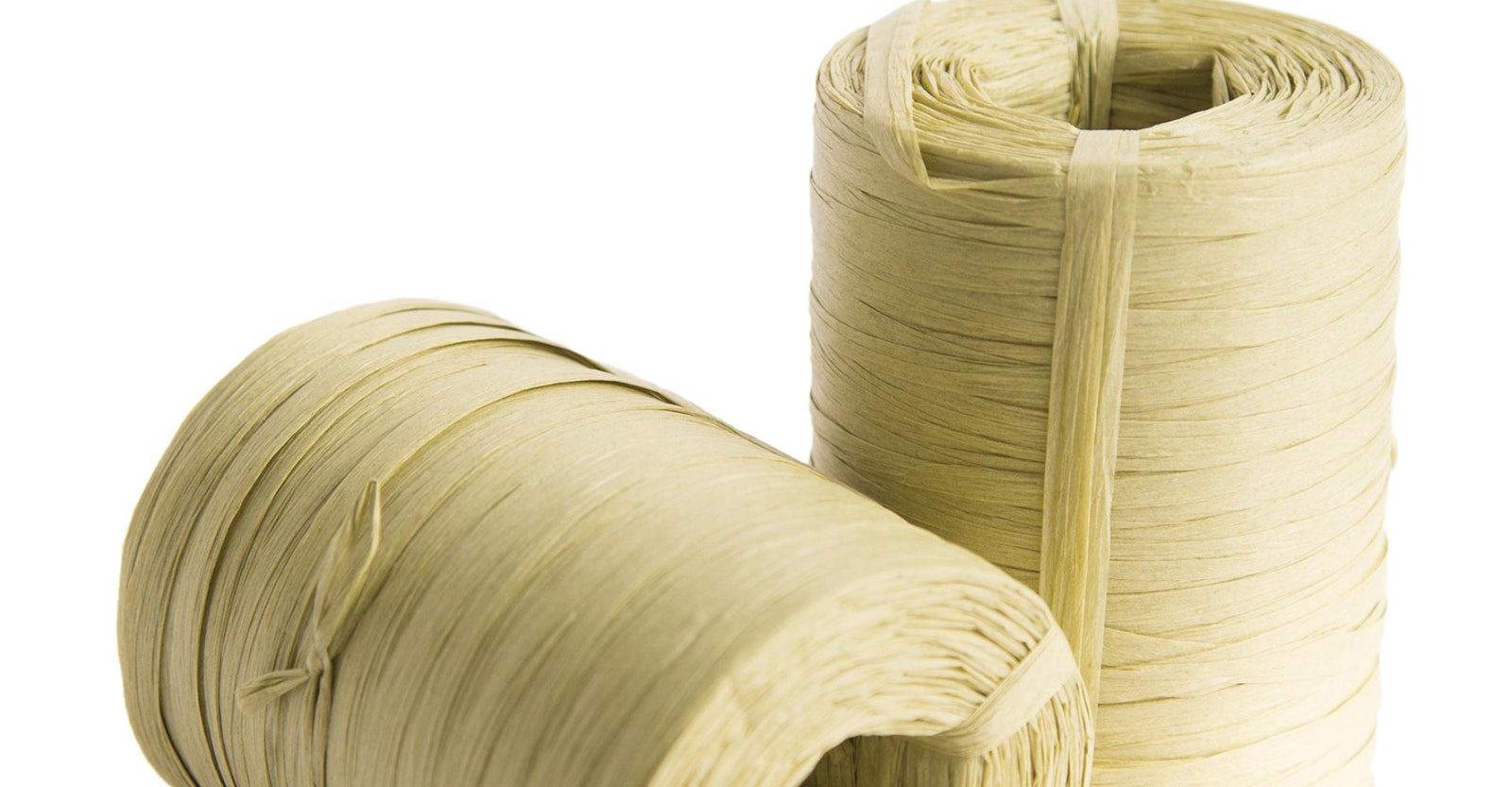You are probably familiar with the raffia sold at craft stores that comes in bundles of short lengths, and is very uneven. This new type of raffia is even, strong, and is put up in skeins. Kate Lange-McKibben put Ra-Ra Raffia through it paces for our Yarn Lab in Handwoven March/April 2020. -- Susan
THE YARN
Ra-Ra Raffia, 100% long wood fiber, 273 yd/100 g skein.
While weaving with raffia takes a bit of patience, it is worth spending the extra time for the results achieved. For my first samples, I used it as weft with a warp of Maurice Brassard et Fils 8/2 cotton. Once I built up my confidence, I used the raffia as warp and found it to be quite strong. As warp, the raffia was able to handle the friction and tension that came from being used on a four-shaft loom and held up even better on a rigid-heddle loom.
When winding off the skein, I pulled 5 to 6 yards from the center and then wound it on my stick shuttle as flat as possible. As I wove, I untwisted the raffia as needed within the shed before I brought the beater or heddle forward. I treated the selvedges as I would if I were weaving with rags: if the last warp end is up, fold the raffia down; if the last warp end is down, fold the raffia up. I paired the raffia with 8/2 cotton in most of my samples, which worked well, although I think 5/2 cotton would also pair nicely with it.
SAMPLE 1: Summer and Winter
For the first sample, I chose a structure that I knew would work well for placemats and runners. I wanted a sett that would be stable and highlight the raffia, so I began with 18 ends per inch (epi). I found that sett to be too tight for the raffia pattern weft and adjusted it to 16 epi. This was much better for the patterning but required that I beat the plain-weave hems softly.
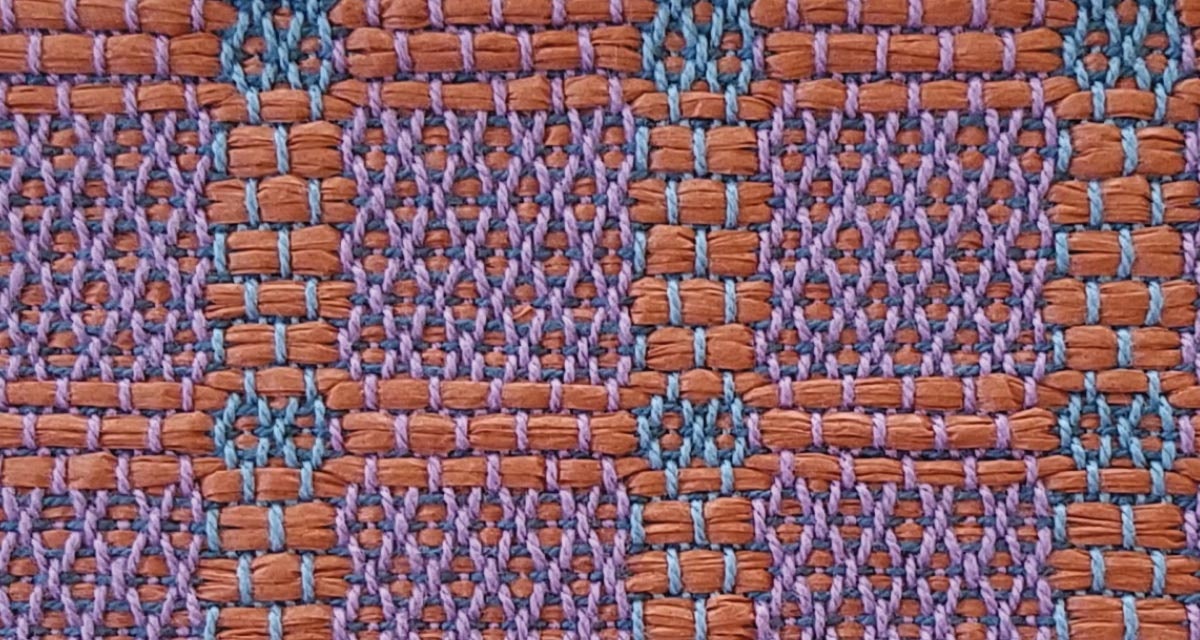
Sample Yarns: Warp: 8/2 cotton, #1507 Lilas and #4274 Bleu Cobalt; tabby weft: 8/2 cotton, #94 Vieux Bleu; pattern weft: Ra-Ra Raffia, Cinnamon Dust.
Setts: 16 epi; 10 ppi for tabby and pattern.
Shrinkage in length: 10%.
Shrinkage in width: 2%.
SAMPLE 2: Honeycomb
For this sample, I chose honeycomb because I wanted to showcase the raffia as the outline for cells. Because of the long floats on the back, this fabric would be best for lined bags or pillows.
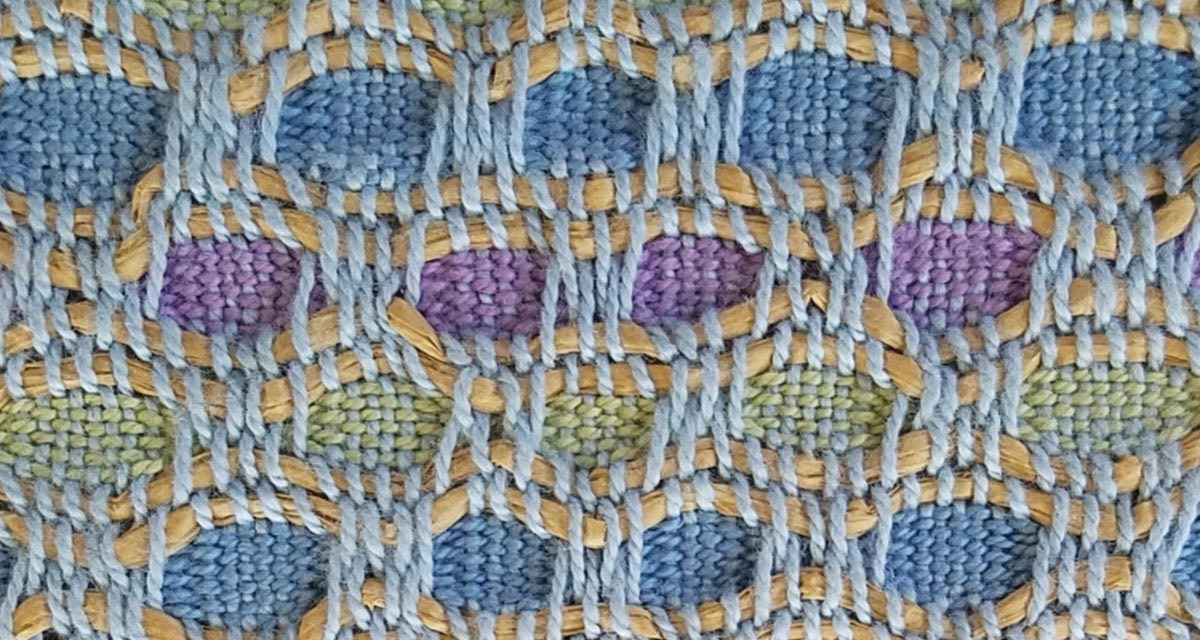
Sample Yarns: Warp: 8/2 cotton, #756 Bleu Pale; weft: 8/2 cotton, #1507 Lilas, #4274 Bleu Cobalt, and #5139 Lime; Ra-Ra Raffia, Desert Palm.
Setts: 18 epi; 24 ppi.
Shrinkage in length: 12%.
Shrinkage in width: 5%–7%.
SAMPLE 3: Crammed and Skipped Dents
I wanted to weave something for outdoor runners and placemats and figured this technique would do the trick. To hold the raffia weft in place, I started and ended each sample with a few picks of 8/2 cotton and then used the ends that were in the crammed dents to make twisted fringe.
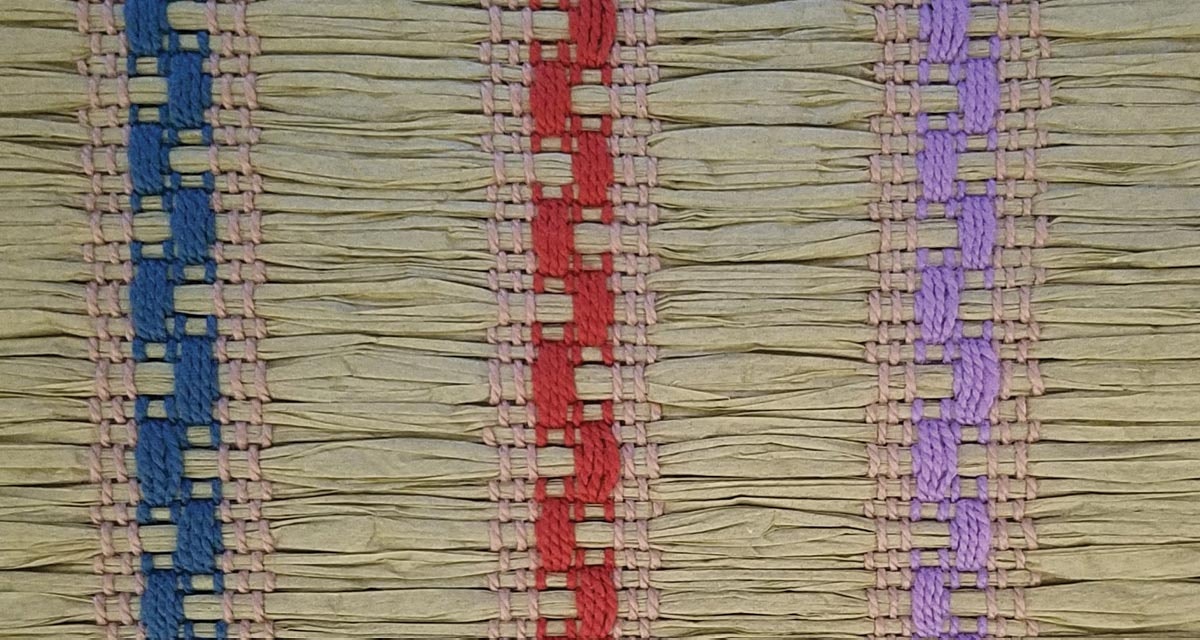
Sample Yarns: Warp: 8/2 cotton, #913 Beige, #985 Brique, #4272 Bleu, #1316 Rouille, and #1507 Lilas; weft: Ra-Ra Raffia, Dune Green.
Setts: 18 ends in 9 dents of a 12-dent reed (2-1-2-3-2-3-2-1-2), 28 epi, then skip 11 dents; 15 ppi.
Shrinkage in length: 11%.
Shrinkage in width: 0%.
SAMPLE 4: Plain Weave
To test the raffia’s strength as warp, I wove this sample on a rigid-heddle loom. I threaded the raffia in the slots and doubled 8/2 cotton in the holes. This fabric would work well for pillows or bags. I didn’t have a 10-dent heddle to test my theory, but my feeling is that 10 epi would result in a more balanced weave.
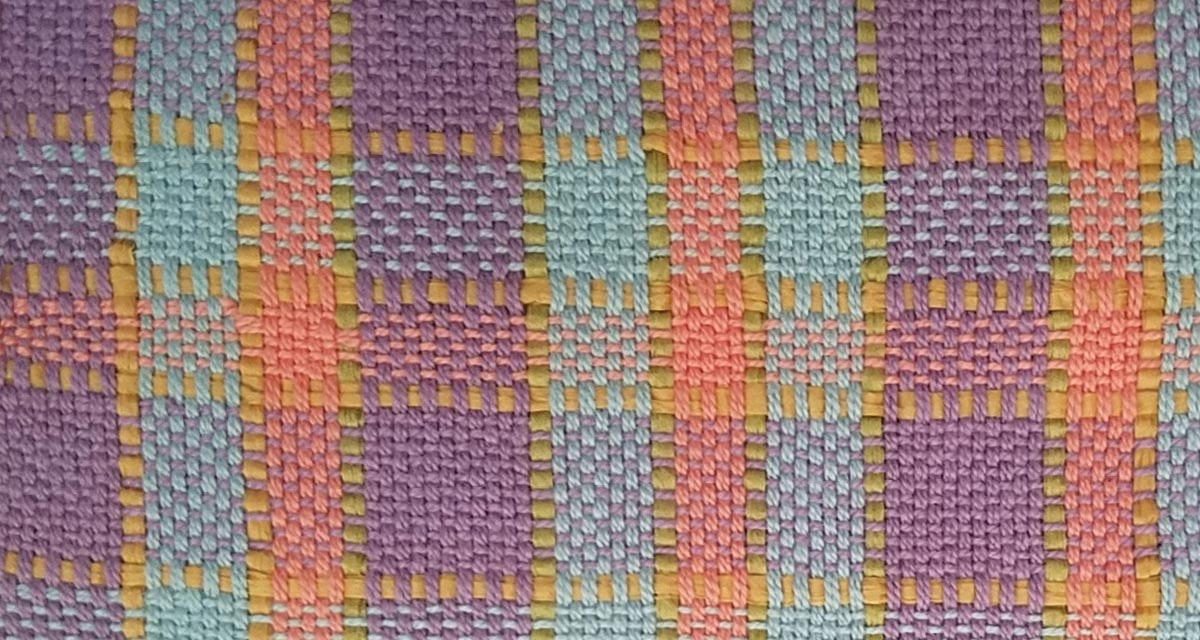
Sample Yarns: Warp: 8/2 cotton, #1507 Lilas, #756 Bleu Pale, and #1317 Saumon; Ra-Ra Raffia, Dune Green; weft: 8/2 cotton, #1507 Lilas, #756 Bleu Pale, and #1317 Saumon; Ra-Ra Raffia, Desert Palm.
Setts: 12 epi (2 ends of cotton per hole in a 12-dent heddle and 1 end of raffia per slot); 16 ppi.
Shrinkage in length: 5%.
Shrinkage in width: 3%.
SAMPLE 5: Plain Weave, Color-and-Weave
I was finally ready to use the raffia alone in the warp. I wove a color-and-weave sample at a 4-inch width with epi and ppi of 8. When I wove a second sample with a width of 7 inches, also at 8 epi, I found I could no longer beat it square, resulting in 6 ppi. For weaving wider fabrics, I suggest opening up the sett to 6 epi if you want a balanced weave. This fabric would make wonderful mug mats, runners, or placemats.
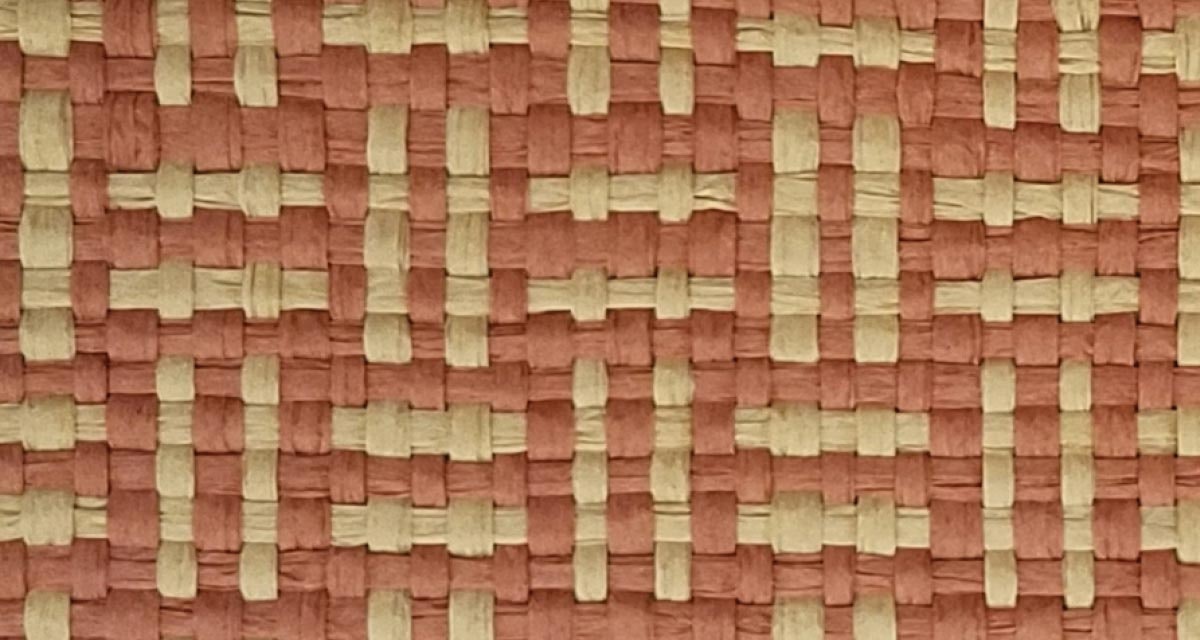
Sample Yarns: Warp: Ra-Ra Raffia, Desert Palm and Cinnamon Dust; weft: Ra-Ra Raffia, Desert Palm and Cinnamon Dust; 8/2 cotton, Vieil #1418.
Setts: 8 epi; 6 ppi.
Shrinkage in length: 3%–4%.
Shrinkage in width: 2%.
FINAL THOUGHTS
Any extra time spent carefully placing the weft yarns is minor compared to the results of the final product and, in fact, made for a very enjoyable weaving process. The raffia does not shrink—well, maybe a little. All pieces were handwashed and then went into the dryer for a very short time with a towel. I laid them flat to air-dry and then pressed them with a warm iron. I found that the raffia dried slowly in my humid Pacific Northwest home. Ra-Ra Raffia is wonderful for weaving fabric for bags, mats, and outdoor pillows and cushions.

